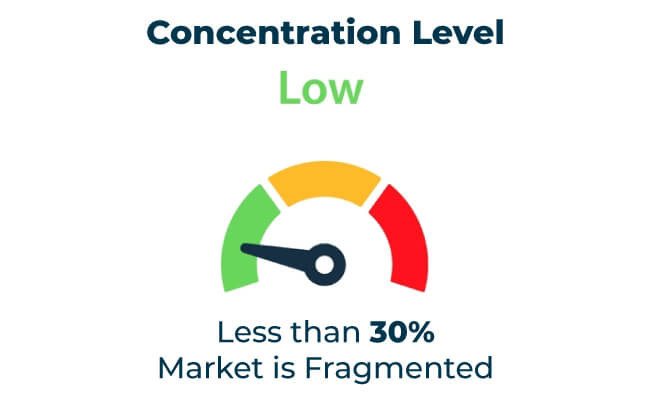The linerless label market is undergoing significant growth as companies adopt sustainable, efficient, and cost-effective labeling solutions. Linerless labels, which eliminate the need for a release liner, reduce waste and improve productivity.
By 2035, the market is projected to reach USD 3.2 billion, growing at a compound annual growth rate (CAGR) of 4.2%. Key trends include sustainability, advanced printing technologies, and the rise of automation in labeling processes, aligning with industry demands for efficiency and environmental responsibility.
Manufacturers are leveraging advancements in adhesives, printing techniques, and application systems to meet the diverse needs of industries such as food and beverage, logistics, and pharmaceuticals. Collaboration with end-users ensures that linerless label solutions align with operational and sustainability goals.
| Attribute | Details |
|---|---|
| Projected Value by 2035 | USD 3.2 billion |
| CAGR during the period 2025 to 2035 | 4.2% |
Explore FMI!
Book a free demo
Factors Driving Market Growth
The linerless label market is expanding due to increasing demand for eco-friendly and cost-efficient labeling solutions. Technological innovations and regulatory pressure to reduce waste further fuel growth.
Global Market Share & Industry Share (%)
| Category | Market Share (%) |
|---|---|
| Top 3 Players (CCL Industries, Coveris, Ravenwood) | 12% |
| Rest of Top 5 Players (SATO, Avery Dennison) | 08% |
| Next 5 of Top 10 Players | 06% |
Type of Player & Industry Share (%)
| Type of Player | Market Share (%) |
|---|---|
| Top 10 Players | 26% |
| Next 20 Players | 42% |
| Remaining Players | 32% |

Year-on-Year Leaders
Emerging markets in Asia-Pacific, Africa, and South America offer growth potential. Affordable and scalable linerless labeling solutions are particularly in demand in these regions.
| Region | North America |
|---|---|
| Market Share (%) | 30% |
| Key Drivers | Emphasis on sustainability and automation. |
| Region | Europe |
|---|---|
| Market Share (%) | 35% |
| Key Drivers | Stringent waste reduction regulations. |
| Region | Asia-Pacific |
|---|---|
| Market Share (%) | 25% |
| Key Drivers | Growing industrialization and e-commerce expansion. |
| Region | Other Regions |
|---|---|
| Market Share (%) | 10% |
| Key Drivers | Demand for affordable and eco-friendly labeling. |
The linerless label market will grow through advancements in adhesive systems, automation, and digital printing. Companies prioritizing eco-friendly practices and investing in smart labeling technologies will lead the industry. Automation and AI will optimize application precision, reduce waste, and improve scalability.
| Tier | Key Companies |
|---|---|
| Tier 1 | CCL Industries, Coveris, Ravenwood |
| Tier 2 | SATO, Avery Dennison |
| Tier 3 | UPM Raflatac, Lintec, Reflex Labels |
The linerless label market is poised for robust growth, driven by sustainability trends, technological advancements, and rising demand across industries. Companies investing in eco-friendly materials, advanced automation, and adhesive innovations will secure a competitive edge in this evolving market.
Key Definitions
Abbreviations
Research Methodology
This report relies on primary research, secondary data analysis, and market modeling. Industry experts and key stakeholders validated insights.
Market Definition
The linerless label market includes sustainable and efficient labeling solutions for food, logistics, retail, and pharmaceutical industries, addressing waste reduction and efficiency needs.
Demand for sustainable, cost-efficient, and high-performance labeling solutions drives market growth.
the market is projected to reach USD 3.2 billion, growing at a compound annual growth rate (CAGR) of 4.2%.
CCL Industries, Coveris, and Ravenwood lead the market, focusing on innovation and sustainability.
High initial investment costs, technical complexities, and limited awareness in some regions are significant challenges.
Opportunities include growth in e-commerce, adhesive innovations, and market expansion in emerging economies.
BOPP Film Market Analysis by Thickness, Packaging Format, and End-use Industry Through 2025 to 2035
Korea Tape Dispenser Market Analysis by Material, Product Type, Technology, End Use, and Region through 2025 to 2035
Medical Transport Box Market Trend Analysis Based on Material, Capacity, End-User and Regions 2025 to 2035
Japan Heavy-duty Corrugated Packaging Market Analysis based on Product Type, Board type, Capacity, End use and City through 2025 to 2035
Corrugated Board Market Analysis by Material and Application Through 2035
Waterproof Packaging Market Trends - Demand & Industry Forecast 2025 to 2035

Thank you!
You will receive an email from our Business Development Manager. Please be sure to check your SPAM/JUNK folder too.